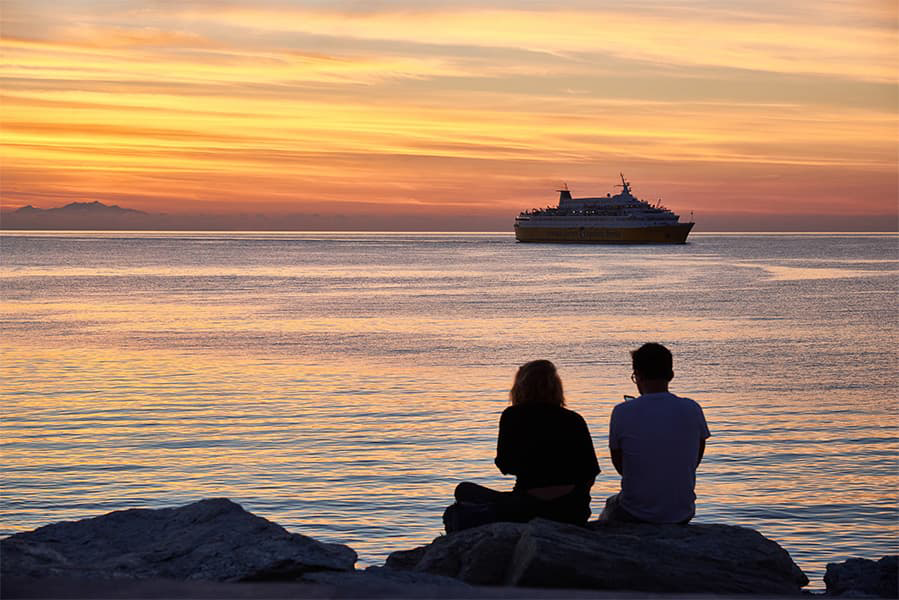Las Palmas - Santa Cruz de Tenerife
Ferries to Tenerife
Las Palmas - Santa Cruz de Tenerife
Ferries to Tenerife

Naviera Armas provides the ferry from Las Palmas to Santa Cruz de Tenerife. Las Palmas Santa Cruz de Tenerife ferries cost around $101 and $515, depending on ticket details. Prices exclude any service fees. Ferry schedules change seasonally, use our Deal Finder to get the latest ferry ticket information for Las Palmas Santa Cruz de Tenerife ferries.
Las Palmas Santa Cruz de Tenerife ferry sailings typycally depart from Las Palmas at around 06:00. The last ferry leaves at 20:15.
The Las Palmas Santa Cruz de Tenerife ferry trip can take around 1 hour 40 minutes. Crossing times can vary between ferry operator and seasons.
There are around 38 weekly sailings from Las Palmas to Santa Cruz de Tenerife serviced by Naviera Armas. Timetables can vary by season and operator.
Las Palmas Santa Cruz de Tenerife ferry prices typically range between $101* and $515*. The average price is typically $226*. The cheapest ferries from Las Palmas to Santa Cruz de Tenerife start from $101*. The average price for a foot passenger is $225*. The average price for a car is $264*.
Ferry price can vary based on booking factors such as number of passengers, vehicle type sailing times. Pricing is taken from searches over last 30 days and exclusive of service fees, last updated December 25.
The distance between Las Palmas to Santa Cruz de Tenerife is approximately 62 miles (99km) or 54 nautical miles.
Yes, Naviera Armas allow cars on board ferries between Las Palmas and Santa Cruz de Tenerife. Use our Deal Finder to get live pricing for car ferries between Las Palmas and Santa Cruz de Tenerife.
Foot passengers can travel on the Las Palmas to Santa Cruz de Tenerife ferry with Naviera Armas.
Pets can travel on ferries from Las Palmas to Santa Cruz de Tenerife with Naviera Armas. Pets may have to stay in the vehicle during the journey depending on the operators guidelines.
More routes than anyone else.

Compare fares, times & routes in one place.
Change plans easily with flexi tickets.

Book e-tickets & manage trips in-app.
Live ship tracking & real-time updates.

Top-rated customer support when you need it.
| Las Palmas - Santa Cruz de Tenerife Ferry Route Summary | ||
|---|---|---|
| Departure Country | Gran Canaria | |
| Destination Country | Tenerife | |
| No. of Operators | 1 | |
| Operators | Naviera Armas | |
| Average Price | $226 | |
| Average Daily Sailings | 5 | |
| Average Weekly Sailings | 38 | |
| Average Sailing Duration | 1 h 40 m | |
| Fastest Sailing Duration | 1 h 40 m | |
| First Ferry | 06:00 | |
| Last Ferry | 20:15 | |
| Distance | 54 Nautical Miles | |
* Prices subject to change, pricing is taken from last 30 days, last updated 1 December 2025.
Las Palmas, officially named Las Palmas de Gran Canaria, is a city and capital on the Spanish island of Gran Canaria in the Canary islands. The city is roughly 150 km from the African coast and is located in the north east part of Gran Canaria. The city's climate, warm, dry summers and winters that aren't too cold, make it a popular destination for tourists.
The city was founded in 1478 by Juan Rejon and has many things to see and do including a selection of theatre, cinema, opera, music concerts, museums and galleries to enjoy. Two of the most popular cultural events held in the city are the Canary Island Music Festival and the International Film Festival. The most important historical buildings in the city can be found in the Vegueta part of the city where some of the buildings have been standing for 500 years. These include the Chapel of San Antonio Abad, the Plaza de Santa Ana which is bordered by the Casas Consistoriales, the Casa Regental, the Obispado and Santa Ana Cathedral.
Las Palmas is the main ferry port on the island. As the island is in the middle of the archipelago, Las Palmas ferry port provides connections to several islands (Fuerteventura, Lanzarote, La Palma, Tenerife) and also the south of Spain (Huelva and Cadiz).
Santa Cruz de Tenerife is a port city located on the Spanish island of Tenerife, the largest of the Canary Islands. The city has an important port and is filled with wide streets, beautiful landscaped areas and some fine examples of modern architecture. The city can trace its back around 400 years when the city began to develop in the late 16th century aided by its port which enabled to city to become the second most populated city in the Canary Islands. The centre of the city sits on the site of the former fortress of San Cristobal and is looked over by the monument dedicated to the Triumph of Candelaria, which is a neoclassical sculpture in Carrara marble and was created by the Italian Pasquale Bocciardo. This part of the city is also overlooked by the 18th century Baroque facade of the La Carta Palace. In the centre of the city, near the sea, several of the busiest streets and squares of the capital meet, such as the Plaza de la Candelaria.
From the city's port there are ferry services departing to mainland Spain and to the other Canary Islands.